The mighty Gas-Planets
The gas-planets show most astonishing characteristics. For example, up to now no explanation is known for stormy surface of Jupiter or the filigree rings of Saturn or why some moons are flying ´reverse´. This chapter presents motion processes of these both gas-planets, which become possible only within a gapless aether-medium. At picture 08.20.01 are listed some data of Jupiter and Saturn, for comparison also of sun and earth.
The upper row shows masses in ratio to earth-mass (M * ERDE). The Saturn is nearby hundred times ´heavier´ than the earth. The Jupiter is still three times more massive than Saturn. However Jupiter even does not ´weight´ the thousand part of sun. So besides some few per-mil, all masses of the system are concentrated at sun - if calculations based on Newton and Kepler would be valid.
One only knows the ´specific weight´ of earth-crust. The estimate of whole earth-mass is pure speculative and thus all deduced data are most vague. One knows the revolution-time and the track-radius of earth running around the sun. One assumes ´constant´ of earthly gravity-forces as universally effecting power (however see chapter 08.16. ´Nature of Gravity and Structure of Earth´). Based on supposed centrifugal forces of earth, the theoretic ´necessary´ masses of other celestial bodies are calculated. Thus are resulting 330000, 318 and 95 times the earth-mass for sun, Jupiter and Saturn - as a ´must´. If gravity is caused by other facts and/or is affecting other kind, these data are illusory.
 At next row is marked the density of celestial bodies by gram per cubic-centimeter (RHO G/CCM), where these 5.5 g/ccm are assumed for the earth. Based on the ratio of demanded masses and measured volumes the average density is deduced: for the sun 1.4 g/ccm, for Jupiter about 1.3 g/ccm and for Saturn only 0.7 g/ccm. Strange enough the smaller gas-planet Uranus again shows higher density of about 1.3 and the once more smaller Neptune even some 1.7 g/ccm (both here not marked).
At next row is marked the density of celestial bodies by gram per cubic-centimeter (RHO G/CCM), where these 5.5 g/ccm are assumed for the earth. Based on the ratio of demanded masses and measured volumes the average density is deduced: for the sun 1.4 g/ccm, for Jupiter about 1.3 g/ccm and for Saturn only 0.7 g/ccm. Strange enough the smaller gas-planet Uranus again shows higher density of about 1.3 and the once more smaller Neptune even some 1.7 g/ccm (both here not marked).
The differing densities are justified by different mixtures of gases and varying temperatures - nevertheless it looks like things are straighten out. For comparison: at earth the gases of air weight about one thousandth gram each cubic-centimeter. Thus within gas-planets, the gases would be compressed about thousand times stronger, at average - based on common sciences, as all gas-atoms are assumed to attract each other, mutually (however see chapter ´08.18. Aether-Physics of Sun´).
Racing Revolutions
The middle row of that graph shows ecliptic radius (RE MKM). The distance between earth and sun is some hundred and fifty million kilometer, Jupiter is five times and Saturn about ten times further away (these 150, 778 and 1429 Mkm). The further outside, the slower becomes turning within plane of ecliptic (row UE A). The earth does one revolution during one year, Jupiter takes already 12 and Saturn needs just 30 years.
That corresponds to regularity of potential vortex, which is turning faster from outside inward (row VE KM/S). Saturn is moving by only 10 km/s, Jupiter with 13 km/s, the earth essentially faster with some 30 km/s. So we are racing around the sun by about 100000 km/h - and notice nothing (because embedded within the aether-vortex).
At three rows below of graph are listed the diameter (D KM) of these celestial bodies, how many hours one revolution takes around own axis (UR H) and thus which turning-speed exists near equator (VR KM/S). The sun has a diameter of 1.4 million kilometer, is turning once within 24 to 36 days, thus surface at equator is moving by about 2 km/s. In comparison, the earth with diameter of just 13000 km looks like a dust-particle. The earth is turning once each 24 hours. So that ´round-about´ at equator is circling by 1660 km/h respective only about 0.5 km/s.
Jupiter with diameter of 142800 km and Saturn with 120000 km appear as huge gas-clouds. One revolution takes only 9.8 or just 10.7 hours. This corresponds to equatorial speed of 12.5 km/s and 9.8 km/s - so rather extreme rotation-velocities. At the other hand there are lots of ´astronomic extremes´: e.g. the Venus takes whole 243 (earth-) days for one single revolution. Opposite it´s told, three times the mass of sun is compressed into diameter of 20 km within neutron-stars and pulsars should rotate by seconds.
Without any doubts, at gas-planets are racing storms up to 300 or even 500 km/h. Without any doubts, the aether can move much faster than materia. So even the whole gas-cloud is turning up to 45000 km/h at the equator, it nevertheless could function as a ´brake block´. At earlier chapters often were discussed the interactions between aether and materia. So at the following only few relevant motion pattern are remembered.
General Swinging
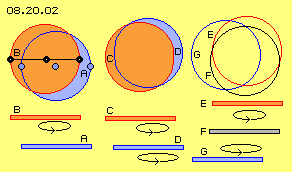 At first, picture 08.20.02 shows three variations and the motions are visualized at following animation. Left side of the picture shows three blue aether-points at a resting level A. Upside of exists a swinging red level B, at which three black aether-points are positioned. Each black point is swinging around its blue point, all are swinging synchronous and distances between points keep constant all times. Also all aether-points at the black connecting-line are shifted parallel all times. With this drawing and animation (each left side) at previous chapter was pointed out, within aether never can exist any rotation (here e.g. the left black point does not rotate around the middle black point) but only these parallel swinging movements (here e.g. the left black point keeps all times left side of the middle black point).
At first, picture 08.20.02 shows three variations and the motions are visualized at following animation. Left side of the picture shows three blue aether-points at a resting level A. Upside of exists a swinging red level B, at which three black aether-points are positioned. Each black point is swinging around its blue point, all are swinging synchronous and distances between points keep constant all times. Also all aether-points at the black connecting-line are shifted parallel all times. With this drawing and animation (each left side) at previous chapter was pointed out, within aether never can exist any rotation (here e.g. the left black point does not rotate around the middle black point) but only these parallel swinging movements (here e.g. the left black point keeps all times left side of the middle black point).
Because all aether is coherent without any gaps between, no aether-point can move independent. Once more must be stated, there are wide layers of aether which are relative resting and at the other hand there are extended layers with likely swinging, e.g. also with stroke-component into similar directions, e.g. in shape of whirlpools.
Differing Swinging
At the middle of previous picture (and animation) again is drawn a red aether-layer C upside of a blue layer D. Like before, the upside red layer is swinging, now however also the blue layer below. Both faces are drawn likely extended and both are swinging left-turning. However the blue face is swinging some faster and at some longer radius.
As often pointed out, each aether-point in principle keeps at a small location, where its motions occur within a narrow room. Nevertheless comes up the impression of wide-rang motions. Left side of picture and animation a part of red face seems to ´rotate´ around resting blue face. At the middle of picture and animation, it seems a blue sickle is rotating around red face. Left side one can see a symmetric turning, while at the middle occurs some rolling motion of differing intensity.
At previous chapters was also discussed, neighbouring layers well can move different kind, e.g. swinging relative to each other. All aether of the layer is shifted by circling motions and parallel. The differences of swinging movements are balanced without problems by cone-like motions of connecting lines (in the vertical direction). Only at the rim of these motion-complexes come up problems by the sideward shifting: anywhere within a layer is ´too less or too much´ aether available momentary (in the horizontal plane).
This appears at overhanging areas, thus here at the blue sickles. Left side of picture, compensation between layers can be done somehow symmetric. At the middle constellation of picture, the compensation however must be done by differing speed, by variable extend and at changing locations.
In order to point out that problem of the motion-complex, right side of picture (and animation) the faces are marked simply by circles. The red layer E is swinging upside of blue layer G. To mark the difference, between both layers is drawn a resting grey layer F (respective a black circle). Now one can see, the curves are mutually crossing by changing angles. The total arrangement sometimes is swinging far off and at the following it is ´calming down´ (somehow like spinning gyroscopes show trembling and tumbling motions).
Forward and reverse Swinging
At picture 08.20.06 left side, again diverse layers are drawn and at each layer one aether-point is marked. The grey layers A are relative resting aether. Between these layers the aether can move some wider. That swinging at increasing tracks here is marked by red connecting-line. All vertical neighbouring aether-points are moving in shape of a ´double-cone´ respective here at that multilayered arrangement as a ´double-crank´ (see previous chapters).
 The grey layers A practically represent neutral zones and between exist belts of individual swinging motions. The dark-red layer B for example could swing more intensive than the light-red layer C. Both could swing synchronous or by different frequencies respective speeds. Between the neutral zones can exist small or wide belts. It´s even possible, below / upside of a neutral zone exist left- or right-turning swinging motions.
The grey layers A practically represent neutral zones and between exist belts of individual swinging motions. The dark-red layer B for example could swing more intensive than the light-red layer C. Both could swing synchronous or by different frequencies respective speeds. Between the neutral zones can exist small or wide belts. It´s even possible, below / upside of a neutral zone exist left- or right-turning swinging motions.
All movements of aether are composed by multiple overlays. Right side of that picture are sketched simple possibilities with only two overlaying circling motions. The black aether-points D are moving like they were guided by a double-arm joint. Upside, the blue circle face E represents a narrow swinging motion (e.g. like at previous neutral layers) around the dark-blue fulcrum with radius R1. The end of that beam could represent an other red fulcrum, where second arm R2 is turning around, thus in principle covering red circle face F.
For example, a narrow swinging of neutral zone can develop to an increasing wider swinging, if radius R2 becomes longer. Also a relative long radius R1 could be overlaid by shorter radius R2, like right-side below is sketched by wide blue circle face G and small red face H. Both overlaying motions could turn likely or opposite sense (see double-arrows). Both motions could turn likely or different speed.
Rolling Motion
Depending on relation of lengths, speeds and turning sense of overlaying motions, differing tracks are resulting for the aether-points of an area. The motion gradually can change from circle to ellipse with variable eccentricity. Smooth transit between motion shapes are possible. The tracks must not be symmetric and even ´tumbling´ structures might come up.
For example, often will come up motion pattern like drawn at picture 08.20.07 upside. At ´rosette-pattern´ A the loops can be round or more acute. The ´oval´ track is not symmetric but the apex wanders around a centre. The turning motions can show into likely or opposite direction (see arrows).
Upside left is sketched a ´double-loop´ B. An aether-point is moving from a narrow loop (light-red) out to a wide loop (dark-red) and back again into the narrow track. The aether-point is moving within space by alternating speeds (marked by the arrows). From inner apex the aether-point is accelerated at an outward showing track. It achieves maximum speed at the outside apex. Afterward, at the inward-track it becomes decelerated again. Like at a ´wobble-disk´ or a ´swing-sander´ the whole surface is moving at such tracks, all neighbouring points parallel to each other.
Stroke
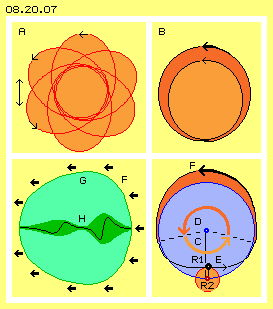 So between neutral layers can exist layers with most different swinging pattern, depending on the overlaying movements. However all kind of overlays have one property in common: the stroke-component. The principle characteristics are show at picture 08.20.07 below right side. As a simple example, only two circle movements are overlaying here within one plane (realiter many motions can overlay into all three dimensional directions).
So between neutral layers can exist layers with most different swinging pattern, depending on the overlaying movements. However all kind of overlays have one property in common: the stroke-component. The principle characteristics are show at picture 08.20.07 below right side. As a simple example, only two circle movements are overlaying here within one plane (realiter many motions can overlay into all three dimensional directions).
The blue circle-face represents the primary motion with radius R1. Below is drawn a small red circle, representing the secondary motion with radius R2 (R2 is about fifth part of R1). Both motions show likely turning sense and both are turning one revolution each time-unit.
The track of black aether-point is flat and inward pressed (below at E) and at the other hand it is enlarged (upside at F). The two dotted lines mark the sections which are done at each half of time. During one time-half the aether-point is moving relative slow a short distance, like marked by short arrow C (light-red). During the second time-half it is moving fast and far within space, like marked by longer arrow D (dark-red).
The aether-point is accelerated from the below to the upside apex and at the following is moving slower back down. Each overlay of aether-movements inevitably results a phase of acceleration and a phase of deceleration. So all times comes up a ´stroke-component´ of motions at the extended section of track (marked dark-red), like here indicated by strong arrow F. Only at previous neutral zones the aether-movements are somehow symmetric. However between neutral zones, the swinging motions of planes and layers must show a stroke-component all times.
Thrust
Only these strokes make aether-movements visible, however only indirect: because the strokes affect as a thrust onto coarse motion-pattern of atoms. That interface between (invisible) aether-movements and the motions of visible materia is often discussed at previous chapters. So here below left, only one sketch is repeated and effect is described in brief: the atom G has an aura (light green) and concentric arranged internal vortices. Depending on chemical element different number of ´winded braids´ are integrated. Here this internal motion pattern is represented by only one ´double-crank´ H (dark green).
When this atom is positioned within an area of stroke-component, a periodical pressure is affecting onto the vortex-unit (see thick arrows F). At phase of fast forward-movement, the aura of atom becomes deformed. The internal spiral motion is compressed in the longitudinal direction and enlarged towards aside. At following phase of slow backward-motion, the ambient aether removes the asymmetry. The atom is pushed back into spherical shape by the general aether-pressure all around.
After each stroke, the atom is shifted some forward. However no ´materia´ is shifted forward within space. Even no aether-point leaves its original location. Only the structure of the motion-pattern is forwarded within the aether. Motions corresponding to that pattern temporary are done by the aether-points some ahead of the track, which the alleged ´solid particle´ is walking through space.
I described that interaction between aether and ´materia´ in diverse context. This understanding of gapless basic substance and its diverse internal motion-pattern makes a clear distinction between my Aether-Physics and other theories and naturally is diametrically opposed to conventional physics. Only at that basis the motions of whirlpools of sun and earth respective here the ´phenomena´ of gas-planets can be explained.
Whirlpools
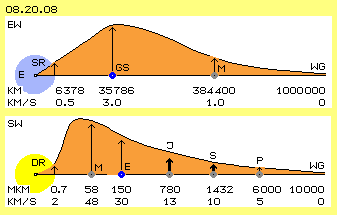 Within vortex-systems around celestial bodies, these strokes are directed circling around, thus into tangential direction anywhere. Picture 08.20.08 shows some data of earth-whirlpool (schematic, i.e. not true to scale). The border (WG) probably is at radius of one million kilometer. From there towards inward the stroke-component of motions is working and e.g. at radius of 384400 km pushing the moon (M) around the earth by speed of about 1 km/s. At height of 35786 km the thrust at material objects achieves speed of about 3 km/s and thus these satellites (GS) are drifting around at space, ´stationary´ to surface of earth.
Within vortex-systems around celestial bodies, these strokes are directed circling around, thus into tangential direction anywhere. Picture 08.20.08 shows some data of earth-whirlpool (schematic, i.e. not true to scale). The border (WG) probably is at radius of one million kilometer. From there towards inward the stroke-component of motions is working and e.g. at radius of 384400 km pushing the moon (M) around the earth by speed of about 1 km/s. At height of 35786 km the thrust at material objects achieves speed of about 3 km/s and thus these satellites (GS) are drifting around at space, ´stationary´ to surface of earth.
Generally thus the trust becomes stronger from outside inward, corresponding to characteristics of a potential-vortex. However that vortex is braked down to 0.5 km/s at equator by the solid earth (E). The earth and ambient aether represents a rigid rotation (SR), at least up to the geostationary satellites.
The sun-whirlpool (SW, at picture below) is wider ´by millions´. The most outside planet Pluto (P) is about six thousand million kilometer (6000 Mkm) far from sun. And the speeds are essentially faster: Pluto still is running about 5 km/s at its eccentric track around sun.
Here now are interesting both inner gas-planets Saturn (S, which at radius of 1432 Mkm is moving by average of 10 km/s) and Jupiter (J, at distance of 780 Mkm running even faster with 13 km/s). The acceleration increases, e.g. to these 30 km/s of earth (E) and finally the 48 km/s of most inner planet Mercury (M).
The red curve shows that tendency of drift-speeds. Opposite to earth-vortex, that ecliptic-vortex is not braked down by force of a central rigid body. The sun (yellow) by itself shows a ´differential rotation´ (DR). Most probably the strokes between Mercury and sun are even stronger and decreases sharp near sun-surface.
Jupiter´s Surface
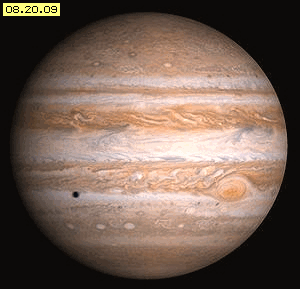 Jupiter and Saturn are much more mighty than the earth and corresponding stronger their aether-whirlpools must be. Like the sun, they are no rigid celestial bodies but exist by gaseous fluids. So high revolution-speeds can reach near to their surfaces. The visible motions of materia and their special behavior allows conclusion about characteristics of invisible aether-whirlpools.
Jupiter and Saturn are much more mighty than the earth and corresponding stronger their aether-whirlpools must be. Like the sun, they are no rigid celestial bodies but exist by gaseous fluids. So high revolution-speeds can reach near to their surfaces. The visible motions of materia and their special behavior allows conclusion about characteristics of invisible aether-whirlpools.
Picture 08.20.09 at first shows a photo of Jupiter. This gas-planet is not as hot like sun with their ´fire-storms´. However one was astonished, the measurement-units at outer clouds registered only minus 123 Grad Celsius (thus just ´warm´ for space-conditions). Once more one must point out, ´temperature´ is an expression for speed of particle-movements. Material particles must not be motionless (and thus ´cold´) if only they are far away from a star.
Like at sun it would be insane to assume, the gas-particles would gather by mutual ´mass-attraction´. However within aether there is a pressure-gradient from chaotic-narrow swinging (e.g. Free Aether of space) towards ordered-wide swinging (e.g. of structured motions within atoms and of atoms). That´s why the ´substantial matter´ is shifted towards the centre. The more gas-particles are pressed from outside to the middle, the stronger rises the contrary pressure inside. The density increases only until an equilibrium of outside and inside pressures is achieved.
So I claim respective it´s quite natural physical fact: at centre the density is much weaker than assumed by common theories. The gas-planet Jupiter has much less mass than commonly calculated. From outside only a static pressure is affecting, which won´t rise up the temperatures. The relative heat of planet´s gases thus must be caused by other facts or processes.
The gases at its surface (and probably hundreds or thousands kilometer deep) show most impressive motions: practically all times the storms up to 500 km/h are racing around, building vortices which again disappear. There are ordered belts with diverse vortices-pattern - and some of these clouds wander opposite to direction of general left-turning. For example, that ´great red spot´ is known for at least 300 years - however the sciences still found no explanation for the movements at surface of Jupiter.
Differential Rotation
This animation is build by photos which were made by approach of space-probe Voyager-1, taken every Jupiter-day same time. One can see how ´clouds´ are shifted, additional to general rotation of Jupiter´s surface. Some spots appear for short moment: the light ones show moons, the dark ones are their shadows. Right side, the picture 08.20.11 shows one photo of the animation. The relative movement of some clear-cut layers are indicated by different arrows.
At the one hand, the sun shows total chaotic movements at the surface. At the other hand however the sun´s ´differential rotation´ is well ordered: fastest turning exists at equator and speed decreases steady towards both poles. At Jupiter it´s quite opposite: at the one hand it shows ordered movement-pattern one knows from air- or water-flows, sometimes e.g. real pretty vortex-braids. At the other hand its surface shows zones and belts with turning-speeds most different. Partial the motions of neighbouring areas are opposite directed.
For a rotating ball it´s just ´absurd´ when both pole-regions are turning contrary directions. An other phenomenon is the ´great red spot´. That whirlwind is wider than the earth. It´s turning around with Jupiter´s surface, ´since ages´ at same place (thus GRS rotates with the surface once during ten hours). However the spot becomes weaker some times and in addition, temporary come up some other spots. Also some known belts disappear occasionally and abruptly re-appear some later.
All these appearances can not be explained by common sciences. For example, these movements are not comparable with the ´weather´ at earth. At Jupiter exist no seas and no land with different heat- and cooling-processes. There are no mountains which could determine the direction of flows. There is even no starting point for understanding the strange behavior of that gas-planet.
Flows by Suction and Pressure and Sun
One can not push ahead gas-particles like a solid body. The gas-particles only fly straight line from one collision to the next. The distance between collisions is the longer, the less particles exist within that area. When the density is different at neighbouring areas, the particles fly automatic from area of high into area of low density.
That´s the only cause for flows within gases. However no ´suction´ is affecting as an attractive force, but suction-areas only offer more space. The particles are not transported based on any ´pressure´. They only and all times fly into that direction they are pushed occasionally by previous collision. Into the direction of a flow however they come forward slower or faster, depending on average speed between collisions. A general acceleration e.g. is achieved when the sun is ´heating-up´ the atmosphere and surface of earth.
At the earth thus the sun is the trigger for atmospheric movements. Jupiter is five times further distant and corresponding weaker is the energy arriving from sun. As no topographic barriers are available, the atmospheric motions would develop other kind. At no case however any ´meteorological´ reason could produce these partial contrary vortices and flow-bands. The real cause of these motion pattern thus must be other kind.
Flow by Aether-Thrust
The second source of movements of material particles within space is previous discussed thrust of asymmetric aether-movements and the stroke-components which inevitably are resulting. Picture 08.20.12 at A shows the disk of a whirlpool. From outside inward the thrust-component becomes stronger (see different red colors and arrows). The curve B marks the different thrust-speeds. Towards the centre, the rotation becomes delayed (light red), e.g. by solid earth or by the accumulation of many gas-particles at sun.
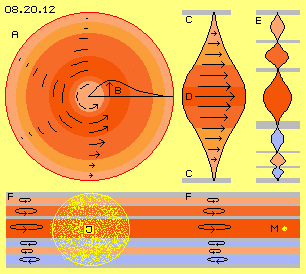 Such whirlpools are relative flat disks which upside and below are bordered by Free Aether. That neutral swinging here is marked by grey layers C. Between these calm faces the aether can swing wider, as marked by double-cone D and arrows of different lengths. So the whirlpools of earth and sun in principle show motion pattern of a ´single-crank´. This sketch is pure schematic. Realiter no connecting-line is swinging and circling around for kilometers. Each single swing- and stroke-motion is ´quantum-small´ and finally the synchronous, parallel and extreme fast motions of aether are resulting these (comparably) slow but wide-range ´flows´ of material particles within space.
Such whirlpools are relative flat disks which upside and below are bordered by Free Aether. That neutral swinging here is marked by grey layers C. Between these calm faces the aether can swing wider, as marked by double-cone D and arrows of different lengths. So the whirlpools of earth and sun in principle show motion pattern of a ´single-crank´. This sketch is pure schematic. Realiter no connecting-line is swinging and circling around for kilometers. Each single swing- and stroke-motion is ´quantum-small´ and finally the synchronous, parallel and extreme fast motions of aether are resulting these (comparably) slow but wide-range ´flows´ of material particles within space.
Multi-Layer Disk
If a solid body exists at the middle of system, the potential-vortex is forced to slow down to a rigid vortex at centre. There can not exist layers with different angle-speeds or contrary turning sense. If however at the middle of a whirlpool exists a sphere of fluids, ´differential rotation´ is possible, like demonstrated by the sun and all gas-planets. Along the rotation-axis, the motions near centre are most intensive and become weaker into the space upside and downside of (like schematic shown by previous single-crank).
The whirlpool of Jupiters is different ´from birth´ or some later was deformed by some hard ´strokes of fate´. Its principle motion-pattern is sketched upside right of that picture at E. There are multiple grey zones showing relative neutral motions. Each between are belts with swinging of different intensity (see different red colors). From layer to layer the turning sense might change: normally left-turning (red) and now here also into opposite turning-direction (blue). Instead of previous single-crank the Jupiter-whirlpool in principle shows the motion-pattern of ´multiple-crank´. Thus the internal movements are multilayered and much more complex.
Primary and secondary Movements
Below at this picture schematic is shown a section cross through the Jupiter-whirlpool with its diverse layers (marked grey, red or blue). At each level exists an other kind of aether-swinging. At each level however the motion-shape is similar in a wide-spread face. That complex vertical motion-pattern F thus exists into horizontal layers left side like right side. That´s the primary aether-swinging at the different layers of that whirlpool.
At a whirlpool the ´dust´ is pushed to the middle all times. Within these vortices-layers here are spread some yellow points J, representing the cloud of gas-particles of planet Jupiter. As a secondary motion now these material particles are shifted and circling around, based on the stroke-component of aether-swinging. Within each layer the gases rotate corresponding to the aether-movements of each level. Further outside also moons (M, yellow) are pushed around corresponding to the stroke-pattern of that area.
Within any gas exist vortices or turbulent flows which calm down sooner or later by internal friction losses of the material motions. Thus also a gas-cloud like Jupiter should calm down soon. The gas-atoms are tiny small local motion-pattern of aether within aether. All atoms together have only few ´mass´ and their motions have only small ´kinetic energy´ - in relation to the volume and ´persistence´ of motions of all gapless aether involved in huge Jupiter-whirlpool. Like at sun or at earth: that ´dust-particle´ at centre of aether-whirlpool is nearby negligible. The ´mass´ of all aether and intertia of its motion is infinite greater than these few and tiny ´material´ vortices - so the aether-whirlpool determines where and how materia behaves.
Thirdly Movement
At surface of Jupiter now a third kind of movements exists, which are based on properties of gases. Upside left at picture 08.20.13 at first schematic is sketched a swinging level A (light red) and below a swinging level B (dark red) and between a neutral zone C (grey). Both swinging layers have a stroke-component like indicated by arrows showing towards right side.
Starting from the grey level, the swinging becomes wider towards upside and below, as schematic sketched by cone-like connecting-lines. Within gapless aether exists no friction because all vertical neighbouring aether-points are moving synchronous, here upward and downward at only gradually enlarged tracks. Total other kind is the behavior of material particles of gases: in principle they are drifting into the direction of strokes, however not as a solid compound but each particle independent and with some distance to the next.
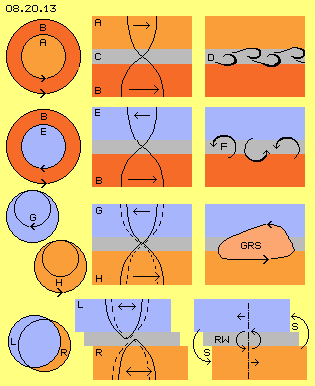 So there will come up collisions and soon the particles are flying ahead, however also cross and to and fro (like usual at normal molecular movements of gases). Especially at the transit areas between the swinging layers, the ´cross-runners´ are accelerated and decelerated. There will come up unordered turbulences or also ordered motion-pattern arise, e.g. as ´vortices-streets´ like sketched at D.
So there will come up collisions and soon the particles are flying ahead, however also cross and to and fro (like usual at normal molecular movements of gases). Especially at the transit areas between the swinging layers, the ´cross-runners´ are accelerated and decelerated. There will come up unordered turbulences or also ordered motion-pattern arise, e.g. as ´vortices-streets´ like sketched at D.
At second row of this picture, below again is drawn a swinging layer B (red), upside however is a layer E (blue) with contrary strokes (see arrows). Within the aether, these motions are possible without friction, because the neutral zone allows smooth transit without problems. The material gases however get ´rubbed´ between the contrary flows. Like indicated right side, at the border-area come up contrary vortices F. There are turbulences which mutually are eliminated by irregular pattern. The equalizing of contrary flows is not only necessary at the visible surface but will build ´tombs´ far down into the gas-cloud.
Stationary Vortices
Picture 08.20.13 at third row shows two double-loops (analog picture 08.20.07 at B). The loop G (blue) is right-turning upside of neutral zone, below of is the loop H (red) left-turning. Both layers are swinging synchronous however contrary to each other. If an aether-point at G is at the most inside point of track, the aether-point H is at its outmost position. At most inner point of track (at G) the motion is very slow, at outmost point of track (at H) much faster. Just at these positions, the difference of speeds is maximum all times. Just there a vortex continuously exists, e.g. the great red spot (GRS, light red).
That remarkable vortex is ´stationary´ within general rotation of the gas-planet since ages. Naturally that vortex is not only running around at surface but will ´drill´ deep into the planet. Just because that ´cyclone´ is anchored by a long vortex-hose deep within the gas-cloud, it can rotate so stabile and stationary. However, other relations of overlaying motions at neighbouring layers can produce vortex-complexes wandering over the surface, forward or backward. Occasionally such ´small red spots´ appear and disappear again.
Tumbling Swinging
The aether by itself is swinging at most narrow radius. The swinging however can be extended, e.g. when the centre by itself is wandering at circling movement of large radius. At upside picture 08.20.07 at A and B were shown two examples in shape of a ´rosette-pattern´ and a ´double-loop´. Already at the beginning, at picture 08.20.02 and according animation, were mentioned surfaces swinging by different frequencies. Inevitably resulting are layers mutually shifted. At the rim come up overhanging parts of faces. Even the true reason are most small motions, such ´sickles´ are racing all around the circumference of system by high speed (details see upside). It´s most probable such appearances come up at surface of Jupiter.
At previous picture 08.20.13 these characteristics schematic are sketched at row below. Upside of a neutral zone (grey) is a swinging layer L (blue) which momentary is shifted some towards left side. Below is a swinging layer R (red) which momentary is positioned some further right side. Both faces could be left- or right-turning (see double-arrows).
These faces reach far out of gas-cloud of Jupiter, like the diverse aether-layers are much wider than that central accumulation of particles. The stroke-components of whirlpool show tangential all around. However at this example, momentary the middle of blue circle L is positioned some further left. So the strokes did guide also the particles of that level some towards left. Opposite at this example is the situation of red circle R below: its middle and thus also its particles are shifted some further right side, momentary.
Border-Vortices
Resulting are ´overhanging´ rims: the blue face reaches out left side ´into free space´ and right side are no particles upside of red partial face (momentary there are no or only few ´material´ vortex-units swimming within the aether). As mentioned upside, within gases exist chaotic motions all times, the separated particles collide and fly off into any direction, towards next collision.
Quite right upside of red face, the space momentary is rather ´empty´, practically representing a suction-area S. If particles by chance got pushed into that direction, they can fly relative long distances until being hindered by following collision. These particles are missing as collision-partners at their original location. So many particles can follow into direction of previous ´empty´ area, so a material flow comes up.
Like shown at upside picture 08.20.02 and by the animation, these sickle-shaped crossing-fields are running around the system by varying intensity. These faces represent circles within which the strokes are directed tangential. If these circles are shifted, also the corresponding accumulation of material particles becomes shifted (into new tangential directions). So within these suction-areas come up border-vortices (see arrow S). These vortices wander all around the planet-surface. As a rule they are turning contrary and eliminate each other or combine to an inward rolling swirl, e.g. with rotor-axis drilling radial into the planet.
Groove at Great Red Spot
Since four hundred years the great-red-spot is under observation. Every hobby astronomer knows and even a pair of binoculars will allow to detect that appearance. A Jupiter-day takes nearby ten earth-hours, so the spot is not visible all day long. One must observe the left edge: if a groove appears, the RGS will follow soon.
That´s a striking evidence of my previous claims concerning the aether-layers, the different swinging inclusive the sideward shifting and resulting motion-pattern at surface of Jupiter - and thus first time a logic deduced and intelligible answer for phenomena, which were absolutely obscure for common sciences up to now.
Galilei-Moons
The Jupiter is surrounded by many moons (about 63 are known now) and their behavior offers additional possibilities for understanding that aether-whirlpool. At the graph 08.20.14 are listed some celestial bodies with the distance towards Jupiter-centre (by thousand kilometer TKM or million kilometer MKM), the revolution-time (in hours h or days d) and the average speed (in km/s). The speed is also marked as a schematic curve (red) at right side.
Like already mentioned, the Jupiter has a radius of about 71200 km. One revolution takes nearby ten hours. At equator thus the speed is about 12.6 km/s.
In 1610 Galileo Galilei discovered four moons, which thus are called ´Galilei-Moons´ (GM). These are named Io, Europa, Ganymed and Callisto. They show diameter from some 3000 up to 5000 km. They are running around Jupiter at distances from four hundred thousand up to nearby two million kilometer. One revolution takes about two days up to two weeks. The most inner moon Io flies most fast with 17.3 km/s and the outmost moon Callisto is only half as fast with its 8.2 km/h.
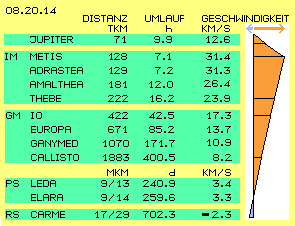 Inner Moons
Inner Moons
In 1892 a stone-chunk (about 135*84*75 km wide) was detected and this moon Amalthea flies astonishing low over Jupiter surface. Finally hundred years later, three more ´Inner-Moons´ (IM) were known. Metis flies again some lower at radius of only 128000 km, Thebe with about 222000 km is some further outside. The most inner moon thus is drifting only some 57000 over the surface.
For comparison: that´s some higher than geostationary satellites fly around the earth. Our moon is turning around at some 384000 km, so at height between Inner- and Galilei-Moons. Our moon travels by one ´tired´ kilometer each second. These Inner-Moons tear along sky of Jupiter by 24 to 32 km/s. Both moons most inside need just seven hours for one revolution, thus they rotate faster than Jupiter by itself.
This corresponds to typical appearance of potential-vortices: the speed rises progressive from outmost Galilei-Moon Callisto to the moon Metis most inside (from 8.2 up to 31.4 km/s). Further inside, within short distance, the speed also progressive is cut down to 12.6 km/s at equator of Jupiter. Like at sun the fast motion reaches near to surface. Finally the turbulences within the accumulation of gas-particles decreases the turning of the vortex strongly - and this is the decisive source of the ´heat´ of the gas-planets.
Prograde Satellites
Much later (in 1904, 1905, 1938, 1973) some ´irregular moons´ were discovered with tracks even more astonishing. It´s suggested they are ´captured strangers´. Opposite to the ´own´ moons they are called ´satellites´. These are rocks with diameters up to 200 km. Here at the graph are marked Leda and Elara as examples for these ´prograde Satellites´ (PS, between are positioned Himalia und Lystithea with similar data). They fly at very eccentric tracks, e.g. between heights of 9 to 14 million kilometer. One revolution takes about eight month, the speed in average is about 3.3 km/s.
Previous four Inner- and four Galilei-Moons circle around Jupiter at heights of few thousand up to two million kilometer and they move nearby exact at the equatorial plane. These four ´irregular-prograde satellites´ show different and special properties: they fly at similar however very eccentric tracks, show similar inclination of 26 to 28 degree to the equatorial plane, all are left-turning, thus ´prograde´.
Retrograde Satellites
Last century were detected some ´irregular-retrograde satellites´ (RS). As a common characteristic, they fly opposite direction, thus are right-turning around Jupiter. As an example here is marked a rock with diameter of some 40 km, named Carme. The track is far beyond of previous celestial bodies, at heights between 17 and 29 million kilometer, extreme eccentric respective shifted aside of centre. All retrograde satellites show similar inclination to equatorial plane: between 145 to 165 degree (so corresponding 15 to 35 degree).
The satellite Carme needs nearby two years for one revolution. Its speed is 2.3 km/s, backward turning. So that speed is marked negative respective blue at right side of graph. At the few years of this century, already many new ´tramps´ with such strange tracks were found (at a whole one knows 63 ´julian´ celestial bodies).
System-contradicting Appearance
The retrograde moons are exceptional within sun-system, as they are moving contrary to general turning sense. If the sun and the planets would result from an inward-turning gas-cloud, all parts should have to rotate likely direction. These retrograde satellites are running contradicting to common sciences. So these retrograde rocks could only come from external areas and only were captured by Jupiter.
Even more grave that dilemma is for my claims: celestial bodies are not pulled via gravity-attraction towards a central mass, but all materia is simply drifting into turning sense within an aether-whirlpool, all around, pure passive. If however now the whirlpool e.g. of Jupiter at the centre is left-turning (except some back-turning layers or internal vortices) and as the moons near centre are left-turning - based on that strict logic no rocks further outside can drift contrary direction within space. If no clear and reasonable answer for this problem can be deduced - one could forget whole theory of that aether-understanding.
Saturn-Rings
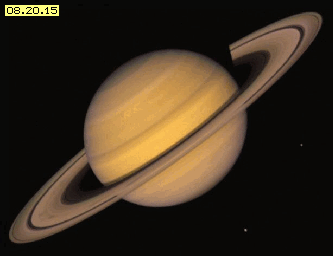 Probably the problem can be solved by analyzing the smaller gas-planet Saturn. Picture 08.20.15 shows this impressive appearance. Also Saturn shows belts at surface and differential rotation, as a whole however its surface is much more uniform than these of Jupiter and sun. Unique is that filigree disk of Saturn-ring: nearby one million kilometer in diameter, however extreme thin with just hundred meter. The disk is build by ice- and stone-rocks in size of dust-particle up to diameter of few meter. The disk is divided into about hundred rings. Like at this picture, often only the rings A and B are visible. Up to now it´s not known, how that fine disk could be build. The thin and sharp contour can not result by mutual attracting forces of involved masses. An explanation is only possible based on aether-movements.
Probably the problem can be solved by analyzing the smaller gas-planet Saturn. Picture 08.20.15 shows this impressive appearance. Also Saturn shows belts at surface and differential rotation, as a whole however its surface is much more uniform than these of Jupiter and sun. Unique is that filigree disk of Saturn-ring: nearby one million kilometer in diameter, however extreme thin with just hundred meter. The disk is build by ice- and stone-rocks in size of dust-particle up to diameter of few meter. The disk is divided into about hundred rings. Like at this picture, often only the rings A and B are visible. Up to now it´s not known, how that fine disk could be build. The thin and sharp contour can not result by mutual attracting forces of involved masses. An explanation is only possible based on aether-movements.
At chapter ´08.17. Aether-Vortex of Earth´ was discussed, how an object could be integrated within a whirlpool and how objects go on circling around the centre. At picture 08.20.16 upside left one corresponding sketch is show once more. The whirlpool is left-turning and the speed, increasing from outside inward is marked, by different green colors. A solid object (A, black) is moving at an ´edge-track´ (black curve). When ever that rock is swimming outward, it is pushed from back-outside into direction forward-inward (see B and the radial arrows respective the red sections). This adaptation process of falling-outward and pressing-inward goes on until the object got an adequate radius. Finally if the speed of object matches with the according thrust, nearby a ´circle-round´ track is achieved (if no further disturbances come up).
At this picture right upside is sketched, all times the inside objects are moving faster (see arrow C). Within the rings of Saturn-whirlpool thus all times the inner rocks are overtaking the outside neighbours. The different size of rocks (see D) lead to relative similar speeds. When ever two rocks of different masses collide, the speed of the heavier one is merely changed. Opposite, each collision results the partial loss of kinetic forward-motion of the light rock. So resulting are speeds with smooth gradients.
Thrust into three Directions
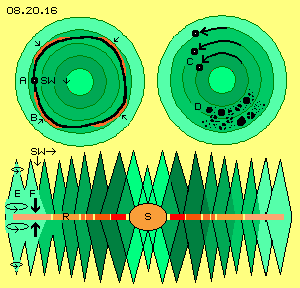 Below of picture, a longitudinal cross-sectional view through Saturn-whirlpool schematic is drawn. In the equatorial plane lays the ring (R) as a very thin disk. The turning speed, increasing from outside inward, is marked by different red colors. The whirlpool of Saturn effects thrust onto material particles into three directions. At first exists a pressure-gradient from outside inward (resulting the accumulation of gas-particles at centre). Secondly exists thrust into tangential direction (which makes the material particles drifting around the centre, from outside inward by increasing speed, here represented by diverse cones from light-green to dark-green).
Below of picture, a longitudinal cross-sectional view through Saturn-whirlpool schematic is drawn. In the equatorial plane lays the ring (R) as a very thin disk. The turning speed, increasing from outside inward, is marked by different red colors. The whirlpool of Saturn effects thrust onto material particles into three directions. At first exists a pressure-gradient from outside inward (resulting the accumulation of gas-particles at centre). Secondly exists thrust into tangential direction (which makes the material particles drifting around the centre, from outside inward by increasing speed, here represented by diverse cones from light-green to dark-green).
These both effects are working in (horizontal) plane of whirlpool. A third pressure-gradient exists right-angles to (thus here in vertical direction). From upside until equatorial plane the swinging becomes wider. Mirror-imaged work the swinging movement below the ring-level, like here indicated by the double-cone and circle-arrows at E. Resulting is a thrust (see arrows F) onto material particles towards the equatorial layer, from upside like from downside. That pressure-gradient is constant all over the disk, independent from distance to the centre of vortex. All ´suspended matter´ of that area thus gathers at that equatorial disk. Obviously there are no disturbances at this area of Saturn, otherwise these razor-sharp borders could not come up. For long, these rings of Saturn were unique appearance within sun-system. Now one knows diverse rings, however less sharp and merely visible.
Pretty turning Rings
At picture 08.20.17 are listed some data and distances and speeds are presented by the graph, upside for Saturn-ring and below for Saturn-moons. The radius of Saturn is 60000 km (= 60 Tkm). The most inner ring starts already 7000 km upside of Saturn surface. Afterward, the disk is divided into several sections. Finally the outmost ring E reaches from 3-times to 8-times the Saturn radius (from 180 to 480 Tkm).
One revolution of rings takes few hours up to maximum four days. The turning-speed outside is about 8.7 km/s and rises up inside, to speeds faster than 20 km/s. Some ´shepherd-moons´ with according behavior are embedded within the ring. The turbulent accumulation of gas-particles with only 10.2 km/s at equator brakes down that huge aether-vortex at its centre. So the movements within Saturn-rings are well corresponding to other aether-vortices. Only that precise arrangement of the thin disk is an expression for especially steady aether-movements - and one may doubt, that pure shape will last for long times.
Disorderly turning Moons
 This strict order no longer exists at outside moons of Saturn and their tracks are merely understandable. Some of these data are listed at below part of picture.
This strict order no longer exists at outside moons of Saturn and their tracks are merely understandable. Some of these data are listed at below part of picture.
The rings reach out one half million kilometer (0.5 Mkm) and are turning there by some 8.7 km/s. At radius of 1.2 Mkm moon Titan does its lonely circling around. One revolution takes 16 days and its speed is about 5.6 km/s. Some further outside exists an other moon Hyperion with analogue data.
Then follows a wide gap e.g. until moon Ijiraq. That chunk with diameter of 12 km is tumbling around at an extreme track with heights between 7 and 15 million kilometer. One revolution takes 15 months by average speed of only 1.8 km/s. A large object with diameter of some 240 km is the moon Phoebe in comparable heights of 11 to 15 Mkm. With poor 1.7 km/s that moon circles around Saturn during 548 days - however backward-turning. Outside of Phoebe are some more moons with diameters of few kilometer. Some are moving forward, most however and all rocks outside of 18 Mkm are turning retrograde. For example, between 15 and 30 Mkm height the Ymir creeps retrograde, by 1.3 km/s during four years, once around Saturn.
The Saturn shows differential rotation, like all gas-planets. However its surface is much less ´stormy´ than the Jupiter surface. At the region of the rings and embedded moons, the aether-vortex of Saturn shows especially steady motion-pattern. The moons respective the ´natural satellites´ further outside however behave just as chaotic as Jupiter´s companions. So the pretty Saturn-ring did not really contribute for solving the problem. Rather it got confirmed, at inner areas of these whirlpools well exist ordered processes, however not perceptible at the wider environment.
At picture 08.20.18 the yellow curves represent the confusing tracks of retrograde satellites of Jupiter. The tracks are strongly eccentric and reach out from 7 to 30 million kilometer. The tracks are not elliptic and Jupiter is not positioned at focal point. The satellites fly by differing speeds, however the speeds do not correspond to the theoretical demanded at different sections. The tracks are ´tumbling´ around the centre and thus these retrograde objects really behave ´irregular´.
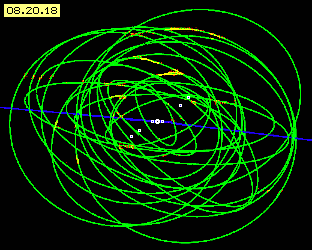 There are only few ´regular´ and prograde-turning moons. They move at essential lower heights and all at a plane with inclination of 27 degree (see white spots). The Galilei-moons fly nearby around Jupiter, nearby exact at plane of ecliptic (blue). Their behavior can be explained by characteristics of the whirlpool and also these 27 degree probably are corresponding to ´galactic wind´ (see earlier chapters). Obviously however the irregular objects already are flying outside of the aether-whirlpool respective within its border-vortices.
There are only few ´regular´ and prograde-turning moons. They move at essential lower heights and all at a plane with inclination of 27 degree (see white spots). The Galilei-moons fly nearby around Jupiter, nearby exact at plane of ecliptic (blue). Their behavior can be explained by characteristics of the whirlpool and also these 27 degree probably are corresponding to ´galactic wind´ (see earlier chapters). Obviously however the irregular objects already are flying outside of the aether-whirlpool respective within its border-vortices.
Edge-Vortices of Aether-Vortex
Picture 08.20.19 shows which motion-pattern at the edge of Jupiter-aether-vortex can come up. Upside left at A, at first is drawn a ´double-crank´ which at most small size e.g. represents an electron. When upside the aether momentary is swinging to left side, the aether below same time is moving toward right side(and vice versa). Within a narrow space balancing movements occur, as the horizontal swinging is accomplished by corresponding swinging into vertical direction (see arrows). So this pattern is predestined for locally concentrated motion-units.
At Jupiter exists a differential rotation, i.e. the aether is swinging different within diverse layers. Each crank even can turn contrary directions to its neighbour. At this picture upside right are drawn such ´contrary-running cranks´. Multiple of these cranks are positioned direct aside each other and are swinging synchronous, so an extended blue layer B momentary is swinging towards left. Below exists the extended red layer C momentary moving towards right. Between exists a grey neutral zone.
Opposite to previous small electron-swinging-pattern, here the balancing movements exist finally far out at the rim of the swinging faces. Upside at picture 08.20.13 was shown, how material gas-particles react at different swinging of neighbouring aether-layers. Via ´suction-effect´ come up turbulences or ordered vortex-streets or even huge stationary whirlwinds. However the swinging aether-layers reach far outside of the surface of gas-planet, by millions of kilometer.
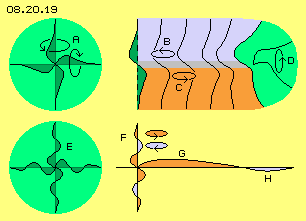 The situation corresponds to motions already shown at upside picture 02.20.02. Especially the swinging circles (right side of animation) demonstrate the differing ´overhang´ at the rims. Finally at these outer areas the contrary movements are mutually equalized respective a compensation occurs e.g. like sketched upside right by green area D.
The situation corresponds to motions already shown at upside picture 02.20.02. Especially the swinging circles (right side of animation) demonstrate the differing ´overhang´ at the rims. Finally at these outer areas the contrary movements are mutually equalized respective a compensation occurs e.g. like sketched upside right by green area D.
Up to here were discussed swinging movements only in horizontal direction. With this balance between the layers comes up an additional movement into vertical direction (see arrow D): the motions are running ´around the edge´, are swinging bottom-up and top-down again, naturally again as a circling movement. So the contrary swinging layers of Jupiter finally end by such edge-vortices. Like at previous discussed material edge-vortices, also these aether-movements will not occur anywhere perfect. So also at the border-areas of Jupiter´s aether-whirlpool well can exist some turbulent movements.
Magnetosphere
There are most differing data concerning the magnetosphere of Jupiter. Towards the sun the sphere could reach out for 3 or 7 million kilometer. Towards outside, the sun-wind could extend the sphere nearby to the Saturn. Like usual are made up the assumptions for a metallic conductor (here compressed hydrogen with electric conductivity) and the electric and magnetic flows would be initiated analogue to generator-technology (an insane idea, e.g. for earthly magnetism).
Like shown by previous chapters, the magnetic field-lines are ´pipes of spiral motions inclusive stroke-component´. That motion shape comes up all times if balancing movements are necessary between neighbouring aether-layers with different stroke-components (and if they are not divided by wide neutral zones). The motion pattern of magnetosphere of the earth e.g. is quite comparable with microscopic-narrow vortices within the border-layers between fluid-flows of different speeds.
The magnetic field of Jupiters is the most strong within whole sun-system. It´s rotating likely sense and speed to general turning of Jupiter´s surface The mighty and steady existing part of magnetosphere reaches out for 1.5 to 3 million kilometer, so at least to the moon Ganymed. This colossus of 5262 km diameter is the unique moon with rotation around its own axis - and thus has also an own magnetic field - just because there must exist ´friction-vortices´ all around.
At this area of Galilei-moons probably occur previous balancing motions between contrary turning layers. The strong swirling processes are the origin of strong Jupiter-magnetism. Based on previous turbulences, also further outside exist magnetic fields, at least by parts. Even wider the general left-turning of the aether-whirlpool is working. Up at heights of 9 to 14 million kilometer the prograde satellites are turning around Jupiter - and strange enough also the Ijiraq, as outmost prograde moon of Saturn, is circling out there.
Forward and backward Stroke
At below row of previous picture, connection-lines are drawn as complex curves. Analogue to upside motion pattern A of electron, the stroke-components of a local motion-unit E could show several windings. This would correspond to contrary strokes of diverse layers at Jupiter. At F schematic is sketches such a multiple-crank, where left-turning strokes are marked red and right-turning stokes are marked blue.
This fictive motion-unit at E represents a ball with analogue motions all around. Opposite, the aether-whirlpools are flat disks, where movements in horizontal direction are much wider stretched than at the vertical line. As the axial (vertical) swinging can be for- and backward turning, naturally also at the horizontal plane could exist stroke-components with and contrary to general turning sense. So a whirlpool at its inner area G could show stroke-components into tangential directions all around (like assumed all times, thus into turning sense, here marked red) and further outside the strokes could be directed reverse (H, marked blue). Material particles of the inner area would drift prograde (as usual) and particles of outside areas would drift retrograde around the centre (as an additional effect of that most wide and complex vortex, e.g. compared with small earth-whirlpool).
Garlands
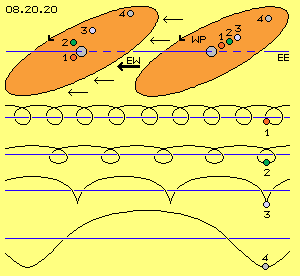 The considerations about behavior of moons may not be restricted to the turning around their planets, but must obey their way through sun-system. At picture 08.20.20 upside right schematic is drawn a whirlpool (WP, light red). The face stands some diagonal to the plane of ecliptic (EE, blue line) like the axis of most planets (grey) or the inclination of moon-tracks. Also four moons (1 to 4) are drawn at different radius.
The considerations about behavior of moons may not be restricted to the turning around their planets, but must obey their way through sun-system. At picture 08.20.20 upside right schematic is drawn a whirlpool (WP, light red). The face stands some diagonal to the plane of ecliptic (EE, blue line) like the axis of most planets (grey) or the inclination of moon-tracks. Also four moons (1 to 4) are drawn at different radius.
Upside left that (fictive) whirlpool is drawn once more, where the moons did move left-turning (from 1 to 4 by decreasing speed). Same time however, the whole whirlpool (inclusive planet and its moons) is shifted some towards left side by the ecliptic-wind (WE, see arrow).
At the second row schematic is sketched, how a fast turning moon (1, red) is moving at a ´garland-shaped´ track through the space. The garland becomes longer stretched for a slower turning moon (2, green). If the circling motion and the forward-movement are likely fast, the moon (3, white) is ´jumping´ ahead. This strange ´hop-track´ does already the Galilei-moon Callisto around Jupiter and the outer parts of ring around Saturn. Satellites turning even slower, no matter whether prograde or retrograde, practically do no revolutions around their planets, but are ´rolling´ respective twisting at spiral tracks (see here moon 4, grey), forward around the sun.
Changing Thrust-Direction
Picture 08.20.21 shows movements around the sun (S, white), e.g. the track of the earth (E, grey) at radius of about 150 million kilometer. There is drawn a whirlpool (WP, dark red) at four positions. An inclination of about 23 to 27 degree is marked by a diagonal white line.
The whirlpool is pushed around the sun by the ecliptic-wind (EW, see arrows). Depending on ´seasons´ the thrust is affecting onto the diagonal (and thus towards the moons) from below or from top (at summer / winter) or from aside (in the spring / autumn). So all objects within the whirlpool do not only drift around the planet but are move at steady changing tracks. All tracks are ´irregular´ deformed more or less and never are matching the suggested exact curves, resulting from fictive formula of celestial mechanics by Newton / Kepler.
Six-Edge Track
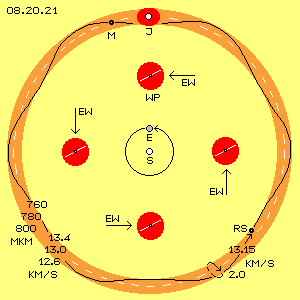 At picture 08.20.21 upside is drawn the Jupiter (J, white) and the motion-room (dark red) of its moons respective natural satellites. There is also marked a moon (M, black) which circles around Jupiter at a distance of about 20 million kilometer (Mkm). The light-red ring marks the way of Jupiter and its companions around the sun - drawn true to scale in ratio to track of earth. Jupiter is moving at an average radius of 780 Mkm by average speed of 13.0 km/s around the sun.
At picture 08.20.21 upside is drawn the Jupiter (J, white) and the motion-room (dark red) of its moons respective natural satellites. There is also marked a moon (M, black) which circles around Jupiter at a distance of about 20 million kilometer (Mkm). The light-red ring marks the way of Jupiter and its companions around the sun - drawn true to scale in ratio to track of earth. Jupiter is moving at an average radius of 780 Mkm by average speed of 13.0 km/s around the sun.
That moon M flies at a spiral track, where the distance to the sun sometimes is only 760 Mkm and at other phase up to 800 Mkm. The moon is pushed forward by the ecliptic-wind by 13.4 or by 12.6 km/s (inside-faster or outside-slower of Jupiter´s constant 13.0 km/s). A ´turn´ of the moon around its planet takes nearby two years and thus is done by speed of about 2 km/s. In reality however, that retrograde satellite (RS, black) is moving at a ´six-edge´ track (see black curve) around the sun, all times forward in turning sense of ecliptic.
This moon does not fly around Jupiter at a ´regular´ track but really behaves beyond all rules of common sciences, alleged to be appropriate and correct. The whirlpool of Jupiter (and also of Saturn) is affecting a thrust up to maximum height of 15 Mkm. So this moon is moving outside of whirlpool of its planet. Its six-edge track around sun is only one or two percent longer as ´the crow flies´ (length of circle section). To keep-up with the 13.0 km/s of its planet, the moon must move faster by only 150 m/s (thus in average must do 13.15 km/s).
Acceleration and Redirection
These outside satellites drift within the ´aether-wind of ecliptic´. When they fly inward (towards sun), they are accelerated up to 13.4 km/s. Afterward they float tangential outward and hit onto layers with weaker forward-stroke of e.g. only 12.6 km/s. The satellites now behave like a ´top-spin-ball´ at tennis: they jump high up from the ground without loosing much speed. Analogue to that known physical effect, these chunks of some kilometer in diameter are pushed back towards inside (nearer to sun).
The comprehensive description of that process is done at previous chapters respective it´s mentioned in brief upside at picture 08.20.07 at G and H. When accelerated at fast-stroke layers, the vortex-complex of an atom is compressed rear-end-inside and some later the aura slackens into direction tangential forward. When the atom arrives at slower layers, the vortex-complex is compressed frontside-outside, it ´stumbles over the brake-block´ and slackens forward-inward. An atom is no ´solid body´, however that vortices-unit of aether within aether finally behaves just like previous ´material´ tennis-ball at the according situation, each single atom and all atoms of that ´irregular´ satellite as a whole.
Overtaking Maneuver
The retrograde satellites do not really turn contrary to their planets. Realiter these moon are only overtaking their planets at the ´sunny-side´. When the satellites come to the outside and slower layers, they are moving slower and fall back behind the planet with its constant speed. Finally ´behind´ the planet, the satellites are shifted inward again. As the whirlpools of planets are some diagonal to plane of ecliptic, by view top-down it looks like a right-turning, retrograde movement of these satellites, opposite to general left-tunring of all other objects.
Upside at picture 08.20.19 was mentioned, there could exist stroke-components in contrary direction at the outside parts of whirlpools. As the gas-planets show intensive swirls at their surfaces, also at the rim of whirlpools might exist turbulent movements. The satellites drifting outward thus will not be rejected exactly mirror-angled all times. Depending on local stroke-component they will be floated back earlier or later, by angles more acute or flat.
Coming and Going
The satellites can be differed into several groups, based on material structures, inclination of tracks and revolution-times. Often they are broken pieces from collisions of larger objects or external objects are ´caught´ by the whirlpool. Depending on all these diverse affects finally these ´chaotic´ tracks are resulting, like shown at previous picture 08.20.18 (nevertheless most satellites show an inclination of only few degree to the ecliptic plane).
Occasionally the satellites are not exact floated back inward, so the track of ´old rocks´ became wider as time went on. Some of observed chunks were no longer detected and thus it´s rather probable some satellites fly up and away from this motion-cluster.
Phenomenon and Phantom
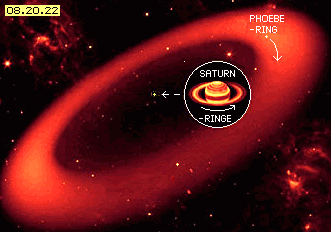 Improved equipment allows to detect many new objects, just within last few years. As soon some data are available, one tries to find the track and predict further movements. It´s absolutely astonishing, sciences are talking about ´irregular satellites´, because normally scientists try to confirm the public audience (or themselves), everything is perfect fitting with laws of celestial mechanics. Realiter however no single track matches exact the theoretic values of Netwon / Kepler calculations (see e.g. ´geostationary satellites of previous chapter).
Improved equipment allows to detect many new objects, just within last few years. As soon some data are available, one tries to find the track and predict further movements. It´s absolutely astonishing, sciences are talking about ´irregular satellites´, because normally scientists try to confirm the public audience (or themselves), everything is perfect fitting with laws of celestial mechanics. Realiter however no single track matches exact the theoretic values of Netwon / Kepler calculations (see e.g. ´geostationary satellites of previous chapter).
From the very beginning one believed, the celestial bodies must move according to holy plan in pure harmony with lovely spheric sounds. No star, no planet and no moon however is forced to paint perfect geometry at sky, must not approve the circle-number phi or must not demonstrate golden-section. It would have made much more sense to see the objects at sky floating within flows, inclusive steady irregularities.
All times come up new phenomenon, e.g. just in 2009 was registered a ring of ice- and durst-particles drifting synchronous to satellite Phoebe retrograde around the Saturn. There the dust-cloud was not concentrated to build a moon. Opposite is suggested, the durst is pushed off the solid celestial body, like e.g. also Io is generating a ring, based on its vulcanic activities. At the fictive picture 08.20.22 the huge relations are impressive: at this ring with a diameter of about 24 million kilometer the huge Saturn inclusive its ring and moons is just a tiny small point.
Invisible Reality
If that Phoebe-Ring would reflect sufficient sun-light, one could see the most wide object of sun-system. However that ´phantom´ shares the fate of invisible objects much wider: the aether-whirlpools of planets and the sun-system as a whole.
At the astronomy today one can detect much more objects and details and can measure much better data than it was possible with old technologies. As long however as the validation of appearances is based on phantom of ´empty space´ and the phenomenon of suggested ´mass-attraction´ - no real progress of understanding the reality will be possible.
With this chapter I wanted - just for fun - to explain the ´impossible´ movements at Jupiter-surface. The retrograde moons forced me to analyze also the ring and moons of Saturn. All these appearances are not to explain by common astrophysics - however are perfectly natural to understand on basis of a gapless aether - even this substance is still invisible.
Evert / 2010-12-12
 At next row is marked the density of celestial bodies by gram per cubic-centimeter (RHO G/CCM), where these 5.5 g/ccm are assumed for the earth. Based on the ratio of demanded masses and measured volumes the average density is deduced: for the sun 1.4 g/ccm, for Jupiter about 1.3 g/ccm and for Saturn only 0.7 g/ccm. Strange enough the smaller gas-planet Uranus again shows higher density of about 1.3 and the once more smaller Neptune even some 1.7 g/ccm (both here not marked).
At next row is marked the density of celestial bodies by gram per cubic-centimeter (RHO G/CCM), where these 5.5 g/ccm are assumed for the earth. Based on the ratio of demanded masses and measured volumes the average density is deduced: for the sun 1.4 g/ccm, for Jupiter about 1.3 g/ccm and for Saturn only 0.7 g/ccm. Strange enough the smaller gas-planet Uranus again shows higher density of about 1.3 and the once more smaller Neptune even some 1.7 g/ccm (both here not marked). At first, picture 08.20.02 shows three variations and the motions are visualized at following animation. Left side of the picture shows three blue aether-points at a resting level A. Upside of exists a swinging red level B, at which three black aether-points are positioned. Each black point is swinging around its blue point, all are swinging synchronous and distances between points keep constant all times. Also all aether-points at the black connecting-line are shifted parallel all times. With this drawing and animation (each left side) at previous chapter was pointed out, within aether never can exist any rotation (here e.g. the left black point does not rotate around the middle black point) but only these parallel swinging movements (here e.g. the left black point keeps all times left side of the middle black point).
At first, picture 08.20.02 shows three variations and the motions are visualized at following animation. Left side of the picture shows three blue aether-points at a resting level A. Upside of exists a swinging red level B, at which three black aether-points are positioned. Each black point is swinging around its blue point, all are swinging synchronous and distances between points keep constant all times. Also all aether-points at the black connecting-line are shifted parallel all times. With this drawing and animation (each left side) at previous chapter was pointed out, within aether never can exist any rotation (here e.g. the left black point does not rotate around the middle black point) but only these parallel swinging movements (here e.g. the left black point keeps all times left side of the middle black point).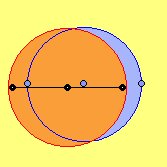
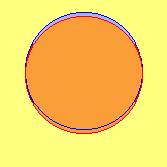
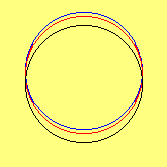
 The grey layers A practically represent neutral zones and between exist belts of individual swinging motions. The dark-red layer B for example could swing more intensive than the light-red layer C. Both could swing synchronous or by different frequencies respective speeds. Between the neutral zones can exist small or wide belts. It´s even possible, below / upside of a neutral zone exist left- or right-turning swinging motions.
The grey layers A practically represent neutral zones and between exist belts of individual swinging motions. The dark-red layer B for example could swing more intensive than the light-red layer C. Both could swing synchronous or by different frequencies respective speeds. Between the neutral zones can exist small or wide belts. It´s even possible, below / upside of a neutral zone exist left- or right-turning swinging motions. So between neutral layers can exist layers with most different swinging pattern, depending on the overlaying movements. However all kind of overlays have one property in common: the stroke-component. The principle characteristics are show at picture 08.20.07 below right side. As a simple example, only two circle movements are overlaying here within one plane (realiter many motions can overlay into all three dimensional directions).
So between neutral layers can exist layers with most different swinging pattern, depending on the overlaying movements. However all kind of overlays have one property in common: the stroke-component. The principle characteristics are show at picture 08.20.07 below right side. As a simple example, only two circle movements are overlaying here within one plane (realiter many motions can overlay into all three dimensional directions). Within vortex-systems around celestial bodies, these strokes are directed circling around, thus into tangential direction anywhere. Picture 08.20.08 shows some data of earth-whirlpool (schematic, i.e. not true to scale). The border (WG) probably is at radius of one million kilometer. From there towards inward the stroke-component of motions is working and e.g. at radius of 384400 km pushing the moon (M) around the earth by speed of about 1 km/s. At height of 35786 km the thrust at material objects achieves speed of about 3 km/s and thus these satellites (GS) are drifting around at space, ´stationary´ to surface of earth.
Within vortex-systems around celestial bodies, these strokes are directed circling around, thus into tangential direction anywhere. Picture 08.20.08 shows some data of earth-whirlpool (schematic, i.e. not true to scale). The border (WG) probably is at radius of one million kilometer. From there towards inward the stroke-component of motions is working and e.g. at radius of 384400 km pushing the moon (M) around the earth by speed of about 1 km/s. At height of 35786 km the thrust at material objects achieves speed of about 3 km/s and thus these satellites (GS) are drifting around at space, ´stationary´ to surface of earth. Jupiter and Saturn are much more mighty than the earth and corresponding stronger their aether-whirlpools must be. Like the sun, they are no rigid celestial bodies but exist by gaseous fluids. So high revolution-speeds can reach near to their surfaces. The visible motions of materia and their special behavior allows conclusion about characteristics of invisible aether-whirlpools.
Jupiter and Saturn are much more mighty than the earth and corresponding stronger their aether-whirlpools must be. Like the sun, they are no rigid celestial bodies but exist by gaseous fluids. So high revolution-speeds can reach near to their surfaces. The visible motions of materia and their special behavior allows conclusion about characteristics of invisible aether-whirlpools.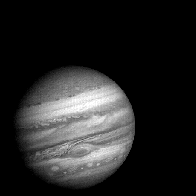

 Such whirlpools are relative flat disks which upside and below are bordered by Free Aether. That neutral swinging here is marked by grey layers C. Between these calm faces the aether can swing wider, as marked by double-cone D and arrows of different lengths. So the whirlpools of earth and sun in principle show motion pattern of a ´single-crank´. This sketch is pure schematic. Realiter no connecting-line is swinging and circling around for kilometers. Each single swing- and stroke-motion is ´quantum-small´ and finally the synchronous, parallel and extreme fast motions of aether are resulting these (comparably) slow but wide-range ´flows´ of material particles within space.
Such whirlpools are relative flat disks which upside and below are bordered by Free Aether. That neutral swinging here is marked by grey layers C. Between these calm faces the aether can swing wider, as marked by double-cone D and arrows of different lengths. So the whirlpools of earth and sun in principle show motion pattern of a ´single-crank´. This sketch is pure schematic. Realiter no connecting-line is swinging and circling around for kilometers. Each single swing- and stroke-motion is ´quantum-small´ and finally the synchronous, parallel and extreme fast motions of aether are resulting these (comparably) slow but wide-range ´flows´ of material particles within space. So there will come up collisions and soon the particles are flying ahead, however also cross and to and fro (like usual at normal molecular movements of gases). Especially at the transit areas between the swinging layers, the ´cross-runners´ are accelerated and decelerated. There will come up unordered turbulences or also ordered motion-pattern arise, e.g. as ´vortices-streets´ like sketched at D.
So there will come up collisions and soon the particles are flying ahead, however also cross and to and fro (like usual at normal molecular movements of gases). Especially at the transit areas between the swinging layers, the ´cross-runners´ are accelerated and decelerated. There will come up unordered turbulences or also ordered motion-pattern arise, e.g. as ´vortices-streets´ like sketched at D. Inner Moons
Inner Moons Probably the problem can be solved by analyzing the smaller gas-planet Saturn. Picture 08.20.15 shows this impressive appearance. Also Saturn shows belts at surface and differential rotation, as a whole however its surface is much more uniform than these of Jupiter and sun. Unique is that filigree disk of Saturn-ring: nearby one million kilometer in diameter, however extreme thin with just hundred meter. The disk is build by ice- and stone-rocks in size of dust-particle up to diameter of few meter. The disk is divided into about hundred rings. Like at this picture, often only the rings A and B are visible. Up to now it´s not known, how that fine disk could be build. The thin and sharp contour can not result by mutual attracting forces of involved masses. An explanation is only possible based on aether-movements.
Probably the problem can be solved by analyzing the smaller gas-planet Saturn. Picture 08.20.15 shows this impressive appearance. Also Saturn shows belts at surface and differential rotation, as a whole however its surface is much more uniform than these of Jupiter and sun. Unique is that filigree disk of Saturn-ring: nearby one million kilometer in diameter, however extreme thin with just hundred meter. The disk is build by ice- and stone-rocks in size of dust-particle up to diameter of few meter. The disk is divided into about hundred rings. Like at this picture, often only the rings A and B are visible. Up to now it´s not known, how that fine disk could be build. The thin and sharp contour can not result by mutual attracting forces of involved masses. An explanation is only possible based on aether-movements. Below of picture, a longitudinal cross-sectional view through Saturn-whirlpool schematic is drawn. In the equatorial plane lays the ring (R) as a very thin disk. The turning speed, increasing from outside inward, is marked by different red colors. The whirlpool of Saturn effects thrust onto material particles into three directions. At first exists a pressure-gradient from outside inward (resulting the accumulation of gas-particles at centre). Secondly exists thrust into tangential direction (which makes the material particles drifting around the centre, from outside inward by increasing speed, here represented by diverse cones from light-green to dark-green).
Below of picture, a longitudinal cross-sectional view through Saturn-whirlpool schematic is drawn. In the equatorial plane lays the ring (R) as a very thin disk. The turning speed, increasing from outside inward, is marked by different red colors. The whirlpool of Saturn effects thrust onto material particles into three directions. At first exists a pressure-gradient from outside inward (resulting the accumulation of gas-particles at centre). Secondly exists thrust into tangential direction (which makes the material particles drifting around the centre, from outside inward by increasing speed, here represented by diverse cones from light-green to dark-green). This strict order no longer exists at outside moons of Saturn and their tracks are merely understandable. Some of these data are listed at below part of picture.
This strict order no longer exists at outside moons of Saturn and their tracks are merely understandable. Some of these data are listed at below part of picture. There are only few ´regular´ and prograde-turning moons. They move at essential lower heights and all at a plane with inclination of 27 degree (see white spots). The Galilei-moons fly nearby around Jupiter, nearby exact at plane of ecliptic (blue). Their behavior can be explained by characteristics of the whirlpool and also these 27 degree probably are corresponding to ´galactic wind´ (see earlier chapters). Obviously however the irregular objects already are flying outside of the aether-whirlpool respective within its border-vortices.
There are only few ´regular´ and prograde-turning moons. They move at essential lower heights and all at a plane with inclination of 27 degree (see white spots). The Galilei-moons fly nearby around Jupiter, nearby exact at plane of ecliptic (blue). Their behavior can be explained by characteristics of the whirlpool and also these 27 degree probably are corresponding to ´galactic wind´ (see earlier chapters). Obviously however the irregular objects already are flying outside of the aether-whirlpool respective within its border-vortices. The situation corresponds to motions already shown at upside picture 02.20.02. Especially the swinging circles (right side of animation) demonstrate the differing ´overhang´ at the rims. Finally at these outer areas the contrary movements are mutually equalized respective a compensation occurs e.g. like sketched upside right by green area D.
The situation corresponds to motions already shown at upside picture 02.20.02. Especially the swinging circles (right side of animation) demonstrate the differing ´overhang´ at the rims. Finally at these outer areas the contrary movements are mutually equalized respective a compensation occurs e.g. like sketched upside right by green area D. The considerations about behavior of moons may not be restricted to the turning around their planets, but must obey their way through sun-system. At picture 08.20.20 upside right schematic is drawn a whirlpool (WP, light red). The face stands some diagonal to the plane of ecliptic (EE, blue line) like the axis of most planets (grey) or the inclination of moon-tracks. Also four moons (1 to 4) are drawn at different radius.
The considerations about behavior of moons may not be restricted to the turning around their planets, but must obey their way through sun-system. At picture 08.20.20 upside right schematic is drawn a whirlpool (WP, light red). The face stands some diagonal to the plane of ecliptic (EE, blue line) like the axis of most planets (grey) or the inclination of moon-tracks. Also four moons (1 to 4) are drawn at different radius. At picture 08.20.21 upside is drawn the Jupiter (J, white) and the motion-room (dark red) of its moons respective natural satellites. There is also marked a moon (M, black) which circles around Jupiter at a distance of about 20 million kilometer (Mkm). The light-red ring marks the way of Jupiter and its companions around the sun - drawn true to scale in ratio to track of earth. Jupiter is moving at an average radius of 780 Mkm by average speed of 13.0 km/s around the sun.
At picture 08.20.21 upside is drawn the Jupiter (J, white) and the motion-room (dark red) of its moons respective natural satellites. There is also marked a moon (M, black) which circles around Jupiter at a distance of about 20 million kilometer (Mkm). The light-red ring marks the way of Jupiter and its companions around the sun - drawn true to scale in ratio to track of earth. Jupiter is moving at an average radius of 780 Mkm by average speed of 13.0 km/s around the sun. Improved equipment allows to detect many new objects, just within last few years. As soon some data are available, one tries to find the track and predict further movements. It´s absolutely astonishing, sciences are talking about ´irregular satellites´, because normally scientists try to confirm the public audience (or themselves), everything is perfect fitting with laws of celestial mechanics. Realiter however no single track matches exact the theoretic values of Netwon / Kepler calculations (see e.g. ´geostationary satellites of previous chapter).
Improved equipment allows to detect many new objects, just within last few years. As soon some data are available, one tries to find the track and predict further movements. It´s absolutely astonishing, sciences are talking about ´irregular satellites´, because normally scientists try to confirm the public audience (or themselves), everything is perfect fitting with laws of celestial mechanics. Realiter however no single track matches exact the theoretic values of Netwon / Kepler calculations (see e.g. ´geostationary satellites of previous chapter).